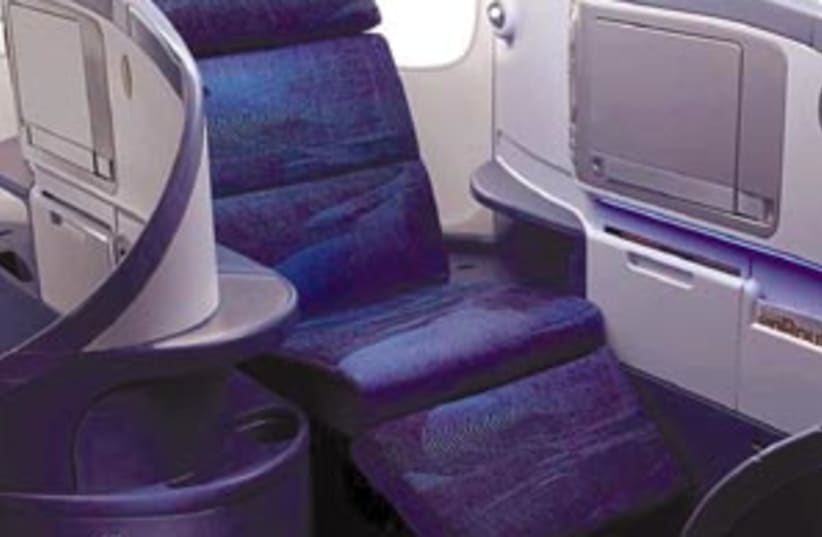In the face of declining figures, Air Canada gets hip - and a facelift
As you arrive at your business-class seat on the Air Canada flight on the Boeing 763 from Tel Aviv to Toronto, a bottle of water is already waiting for you.
As you arrive at your business-class seat on the Air Canada flight on the Boeing 763 from Tel Aviv to Toronto, a bottle of water is already waiting for you.
The daily newspapers (but no business magazines) are distributed by the crew, and once you make yourself comfortable in the wide, green-fabric seats, flipping out into a chair-bed, you're all set for a luxurious lift-off.
Only recently did Air Canada realize that without an extreme upgrade of its dated airplane interiors and entertainment offerings, which rival airlines such as Delta Airlines have already completed over the past few years, it would not be able to compete, especially for business travelers on long flights.
The Canadian airline, which offers passengers direct flights from Tel Aviv to Toronto and Montreal and connects to 67 destinations in Canada and 53 destinations in the US, was this year chosen in a passenger poll as the best North American carrier.
"Air Canada is spending about (CAD) $300 million this year and next on a revitalization program named Project Extreme Makeover (XM) to refurbish the existing aircraft in our fleet," said Dennis Vandal, director of Marketing Communication. "That is in addition to the 30 new aircrafts from Brazil's Embraer SA for North America, and eight Boeing 777s that are already entering our fleet."
The facelift of its old plane interiors and investment in modern entertainment and new movies, the airline hopes, will help the company's Tel Aviv office bring traffic back into the green. Until now, Air Canada has been running old movies.
In contrast with most foreign airlines flying to and from Ben-Gurion Airport, which have largely recovered from the aftermath of the Second Lebanon War last year, Air Canada experienced a drop in traffic from the beginning of this year and into the September season.
A September report from the Israel Airports Authority (IAA) showed that Air Canada was one of just two international airlines to record a decrease in the number of passengers it brought to and from Israel.
About 7.3 percent fewer people traveled to Israel with the Montreal-based airline in September this year than in September 2006, when the war had just ended, while at its rivals (such as Continental), passenger traffic rose by as much as seven percent.
On the whole, international passenger traffic shot up 28.5% in September this year and international aircraft traffic increased 18.4% during the same month.
For the year so far, between January and September, Air Canada's passenger total was down 21% from the equivalent period in 2006.
"In order to speed up the XM Project, which includes the refurbishment of the entire fleet of 230 aircrafts, one daily flight was cut from the Tel Aviv route in the beginning of 2007 and as a result, our passenger seat capacity on the route fell by 27%, which is the reason for the decline of 21% in passenger total numbers in the IAA report," said Air Canada's Tel Aviv office in a statement. "We are expecting to add the flight back on our route in May 2008, when we will be again offering daily flights to Canada."
As part of the XM project, every seat on every aircraft is being replaced. In economy class, touch-screen panels are being fitted on seatbacks, allowing passengers to press options displayed on the screens, and then sit back and enjoy upgraded movie and audio entertainment.
Air Canada's seatback screens also offer interactive games such as puzzles and card games, and each seat will be equipped with plugs for laptops, and to recharge iPods and BlackBerry devices.
For business-class passengers on international flights, Air Canada is upgrading its Boeing 767-300s and Airbus 330s with the new Executive First Suite class, featuring individual suites with lie-flat beds and a personal touch-screen video entertainment system.
"We are also considering offering in-flight Internet services on board," added Louise McKenven, senior director of Product Design at Air Canada.
The writer was a guest of Air Canada in Toronto, Québec City and Montreal.
if(catID != 151){
var cont = `Take Israel home with the new
Jerusalem Post Store Shop now >>

